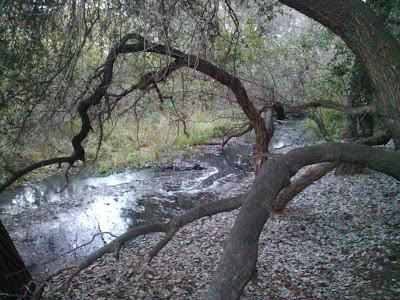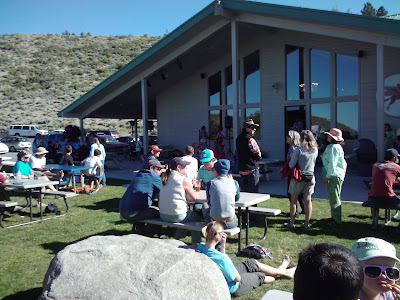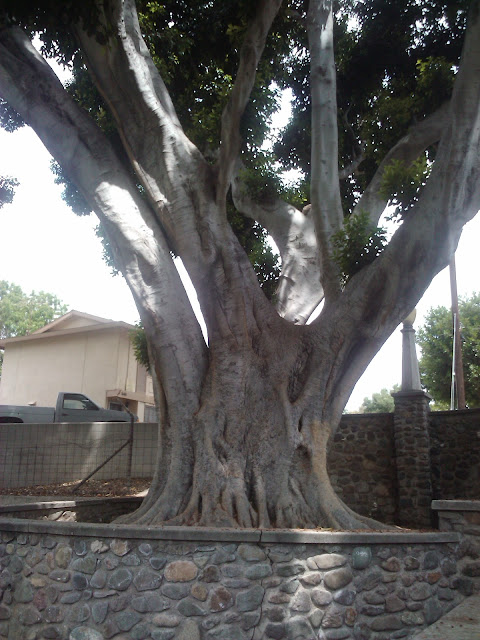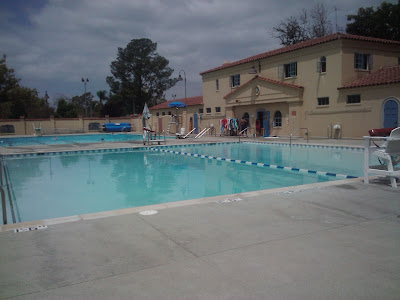I took US-395 on my way north to Washington State from Southern California, beginning at I-15 and ending at I-90. During the 5-day trip, I explored several National Park sites on my way north --
Manzanar National Historic Site (CA),
Devil's Postpile National Monument (CA), and
John Day Fossil Beds National Monument (OR).
 |
Memorial at Manzanar Cemetery “Erected by the Manzanar Japanese,
August 1943”, the front reads “Soul Consoling Tower.” |
Manzanar was the location for 1 of 10 WWII Japanese Relocation Centers. Over 11,000 men, women and children were removed from their homes and required to move into this military-style camp. This barbed-wired enclosure was located in the "Owens Valley at 4,000' elevation, at the eastern base of the Sierra Nevada ... Summer temperatures can soar over 100 degrees. Winter highs are usually in the 40's. Nighttime temperatures year round are 30 to 40 degrees less than daytime highs. High winds are common in any season." (
http://www.nps.gov/manz/)
 |
Two barracks restored. Hundreds of barracks were sectioned into "blocks."
Many families shared a single barrack, using bed sheets for some privacy. |
After exploring the
museum and
touring the old camp roads, I was struck by two realities that I had not previously considered. One was the very non-private nature of the accommodations, including shared housing and shared showers. The other was how the evacuees continued to support their country, even tho' their country had locked them up. At this camp they wove camouflage netting for the troops. Some of the young men even enlisted.
 |
| Morning at the Middle Fork of the San Joaquin River near the Devil's Postpile |
Devil's Postpile National Monument was my next northbound stop. Here I shared my campsite with a mule deer, moved my food to the bear locker, and snuggled down for a good night's snooze.
 |
| View on hike to Devil's Postpile |
 |
| One section of the Devil's Postpile, a columnar basalt rock formation. |
The next morning I explored the banks of the Middle Fork of the San Joaquin River, watching folks having no luck at fishing. I then joined a ranger on a short hike to the Devil's Postpile formation. She talked about the native flora and fanua, some natural history, and the geologic processes that made the formation what it is today. Scientists believe that 100,000 years ago lava pooled to 400' deep at that location. Because it cooled so slowly, the basalt rock naturally formed into columns, mostly 6 sided. It is one of the best known examples of columnar basalt.
 |
A view of some curved columns,
believed to have cooled more quickly than the other columns. |
Currently the Devil's Postpile is 80' high, after being worn down by earthquakes, freeze-thaw cycles, and most especially by glaciers that receded about 15,000 years ago. Very cool.
 |
| Another section of the Devil's Postpile |
John Day Fossil Beds in Oregon was my next stop. This site has 3 units of which I visited 2 --
Sheep Rock and
Painted Hills.
 |
View from Mascall overlook, looking north into the Sheep Rock Unit.
Hwy 28 in the distance goes through Picture Rock Gorge created by the
John Day River erroding basalt rocks from 17 different laval flows.
The peak in the distance is Sheep Rock Mountain. |
The fossils found here help scientists understand the changes that happened once mammals inhabited the planet, as well as the climate changes. The John Day area mammals lived in a very wet climate 30 million years ago, lots of rain, humid, tropical jungles. The animals that lived then were mammals like us (vs. dinasours), but were mostly different from the animals we know today. Then about 15 million years ago, the climate in the area became more like the eastern part of the US, hardwood forests. Again, populated with mammals; and again, largely different from the animals we know today. The John Day area today would be called desert like. So, during the course of 30 million years, it's gone from a wet jungle to dry desert.
 |
Sheep Rock Mountain in the rain -- basalt rock top, dark band from lahar,
and various colors and layers created by volcanic ash |
During the 30 million years, the John Day areas has experienced multiple basalt lava flows, volcanic ash covers, and lahars (hot mud flows). Scientists explore layer upon layer of ash, lahar, ash, and lava in order to discover the fossils of animals and plants that tell their stories, millions of years old.
 |
| Cathedral Rock in the Sheep Rock Unit |
In the Sheep Rock Unit, the Thomas Condon Paleontology Center is a must see. I first watched an introductory film, then walked through the exhibits that tell the 30-million-year story through fossil displays and murals. Another area of the museum provides a large picture window to watch paleontologists working on fossils. Further exhibits explain their methods of unearthing, preserving, cataloging, and understanding the artifacts. Way interesting.
 |
| Colorful formation near picnic area in Sheep Rock Unit. |
I also visited the Painted Hills Unit. Here you have regular desert hills covered with sage; but, among the regular hills are the painted hills of red and yellow. Fossils were found in this area as well; but, I focused on the hills.
 |
| View from Painted Hills Overlook |
"The red in the Painted Hills is from rusty iron minerals, oxidized by long exposure. The golden layers reveal of mix of oxidized magnesium and iron, metamorphic claystone minerals. Black hash marks are rich with manganese. Each color represents a different geologic process." (from infomation board at overlook)
 |
| It rained hard off and on all day in the Painted Hills |
I took a short hike around the small hills at the Painted Cove. To keep the hills as untouched hiker's tramples, the park service built a boardwalk.
 |
| A couple of hikers on the boardwalk at the Painted Cove |
 |
| Close up of a yellow & red hill with pooled rain water |
 |
| Close up example of black manganese hash mark |
 |
| Rain runoff at Painted Cove |
The Painted Hills were totally amazing.






















































